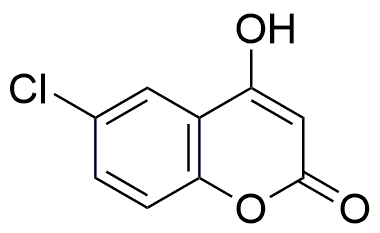6-Chloro-4-hydroxycoumarin is widely utilized in research focused on:
- Fluorescent Probes: This compound is often used in the development of fluorescent probes for biological imaging, enabling researchers to visualize cellular processes in real-time.
- Anticoagulant Research: It serves as a precursor in the synthesis of anticoagulant drugs, which are crucial for preventing blood clots in patients with cardiovascular diseases.
- Photodynamic Therapy: The compound is explored in photodynamic therapy applications for cancer treatment, where it can help in selectively targeting and destroying cancer cells when activated by light.
- Natural Product Synthesis: It plays a role in the synthesis of various natural products, contributing to the development of new pharmaceuticals and agrochemicals.
- Analytical Chemistry: This chemical is used in analytical methods for detecting and quantifying phenolic compounds in environmental samples, aiding in pollution monitoring and control.
General Information
Properties
Safety and Regulations
Applications
6-Chloro-4-hydroxycoumarin is widely utilized in research focused on:
- Fluorescent Probes: This compound is often used in the development of fluorescent probes for biological imaging, enabling researchers to visualize cellular processes in real-time.
- Anticoagulant Research: It serves as a precursor in the synthesis of anticoagulant drugs, which are crucial for preventing blood clots in patients with cardiovascular diseases.
- Photodynamic Therapy: The compound is explored in photodynamic therapy applications for cancer treatment, where it can help in selectively targeting and destroying cancer cells when activated by light.
- Natural Product Synthesis: It plays a role in the synthesis of various natural products, contributing to the development of new pharmaceuticals and agrochemicals.
- Analytical Chemistry: This chemical is used in analytical methods for detecting and quantifying phenolic compounds in environmental samples, aiding in pollution monitoring and control.
Documents
Safety Data Sheets (SDS)
The SDS provides comprehensive safety information on handling, storage, and disposal of the product.
Product Specification (PS)
The PS provides a comprehensive breakdown of the product’s properties, including chemical composition, physical state, purity, and storage requirements. It also details acceptable quality ranges and the product's intended applications.
Certificates of Analysis (COA)
Search for Certificates of Analysis (COA) by entering the products Lot Number. Lot and Batch Numbers can be found on a product’s label following the words ‘Lot’ or ‘Batch’.
*Catalog Number
*Lot Number
Certificates Of Origin (COO)
This COO confirms the country where the product was manufactured, and also details the materials and components used in it and whether it is derived from natural, synthetic, or other specific sources. This certificate may be required for customs, trade, and regulatory compliance.
*Catalog Number
*Lot Number
Safety Data Sheets (SDS)
The SDS provides comprehensive safety information on handling, storage, and disposal of the product.
DownloadProduct Specification (PS)
The PS provides a comprehensive breakdown of the product’s properties, including chemical composition, physical state, purity, and storage requirements. It also details acceptable quality ranges and the product's intended applications.
DownloadCertificates of Analysis (COA)
Search for Certificates of Analysis (COA) by entering the products Lot Number. Lot and Batch Numbers can be found on a product’s label following the words ‘Lot’ or ‘Batch’.
*Catalog Number
*Lot Number
Certificates Of Origin (COO)
This COO confirms the country where the product was manufactured, and also details the materials and components used in it and whether it is derived from natural, synthetic, or other specific sources. This certificate may be required for customs, trade, and regulatory compliance.


